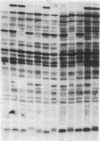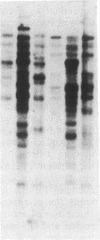Abstract
Five probes localizing to the Xq26-Xqter region of the human X chromosome have been genetically mapped on the mouse X chromosome using an interspecific cross involving Mus spretus to a contiguous region lying proximally to the Tabby (Ta) locus. Pedigree and recombinational analysis establish the marker order as being Hprt-FIX-c11-G6PD-St14-1. The size of this contiguous region is such that the X-linked muscular dystrophy (mdx) mouse mutation probably maps within this segment. This in turn suggests that it is highly improbable that the mouse mdx locus represents a model for Duchenne muscular dystrophy (DMD). It is, however, compatible with the idea that this mutation may correspond in man to Emery Dreifuss muscular dystrophy. The high frequency of restriction fragment length polymorphisms found in this interspecific system for all the human cross-reacting probes examined up until now, using only a limited number of restriction enzymes, suggests that the Mus spretus mapping system may be of great potential value for establishing the linkage relationships existing in man when conserved chromosomal regions are concerned and human/mouse cross-reacting probes are available or can be obtained.
Full text
PDF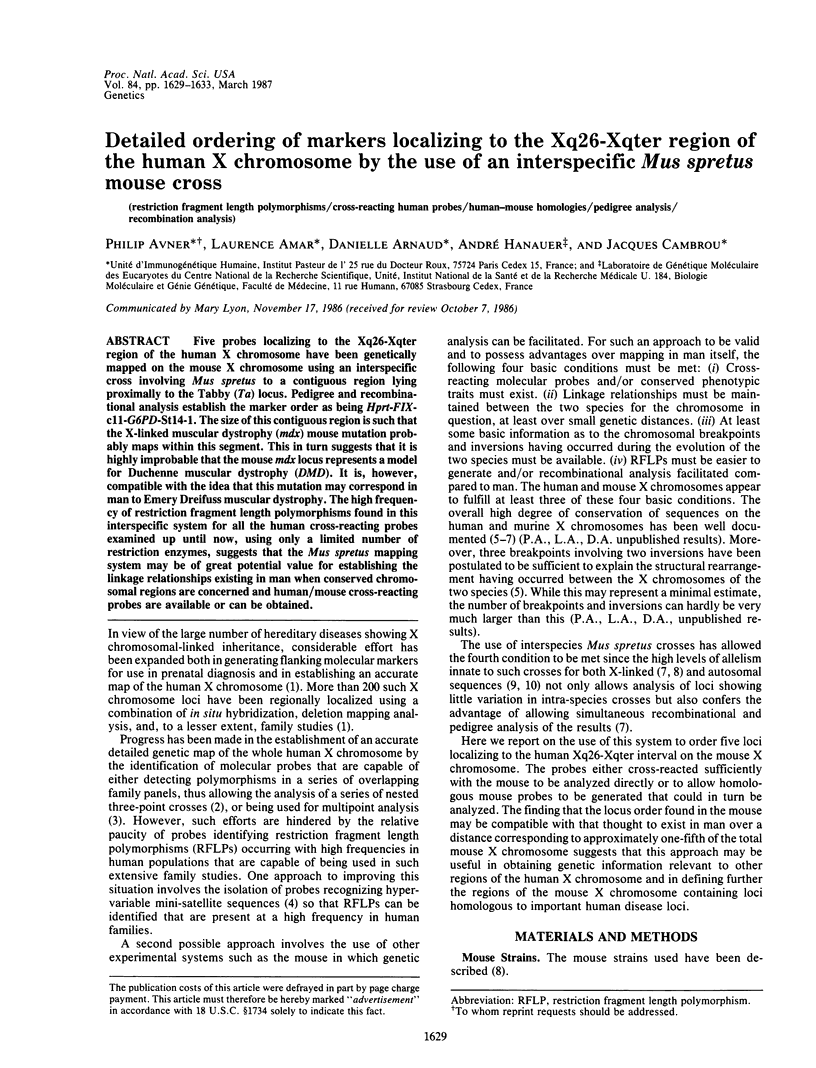
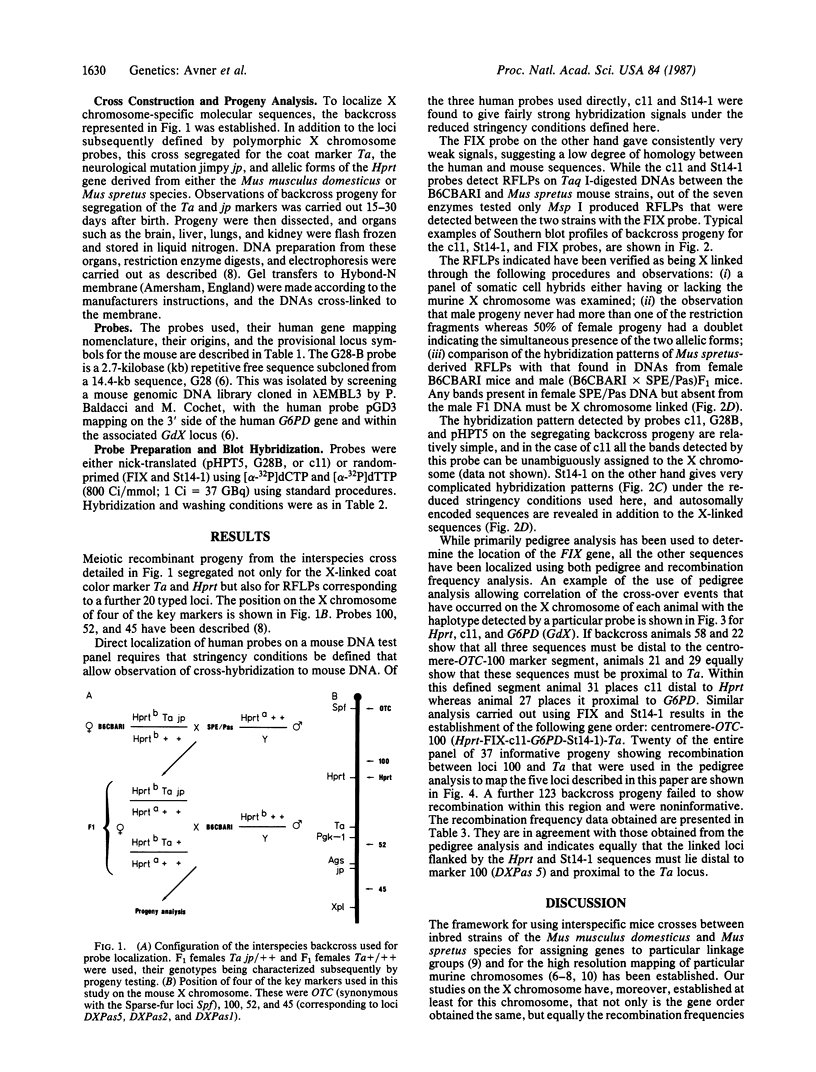
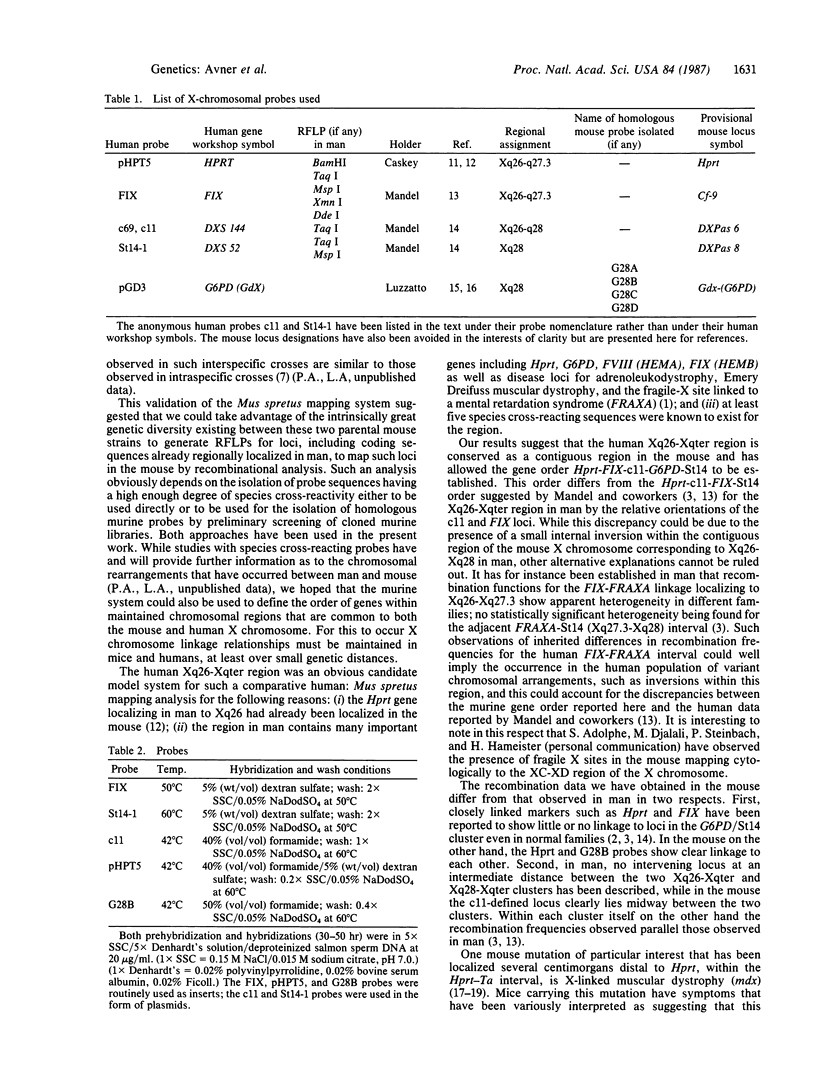
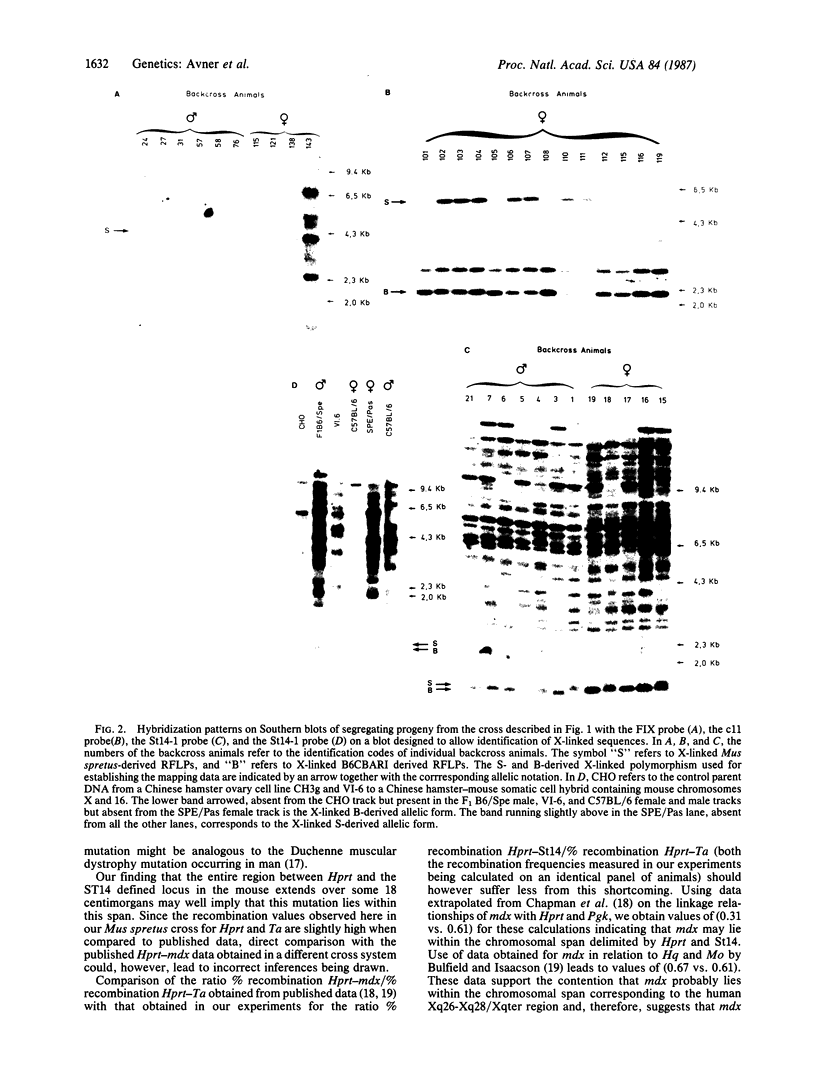
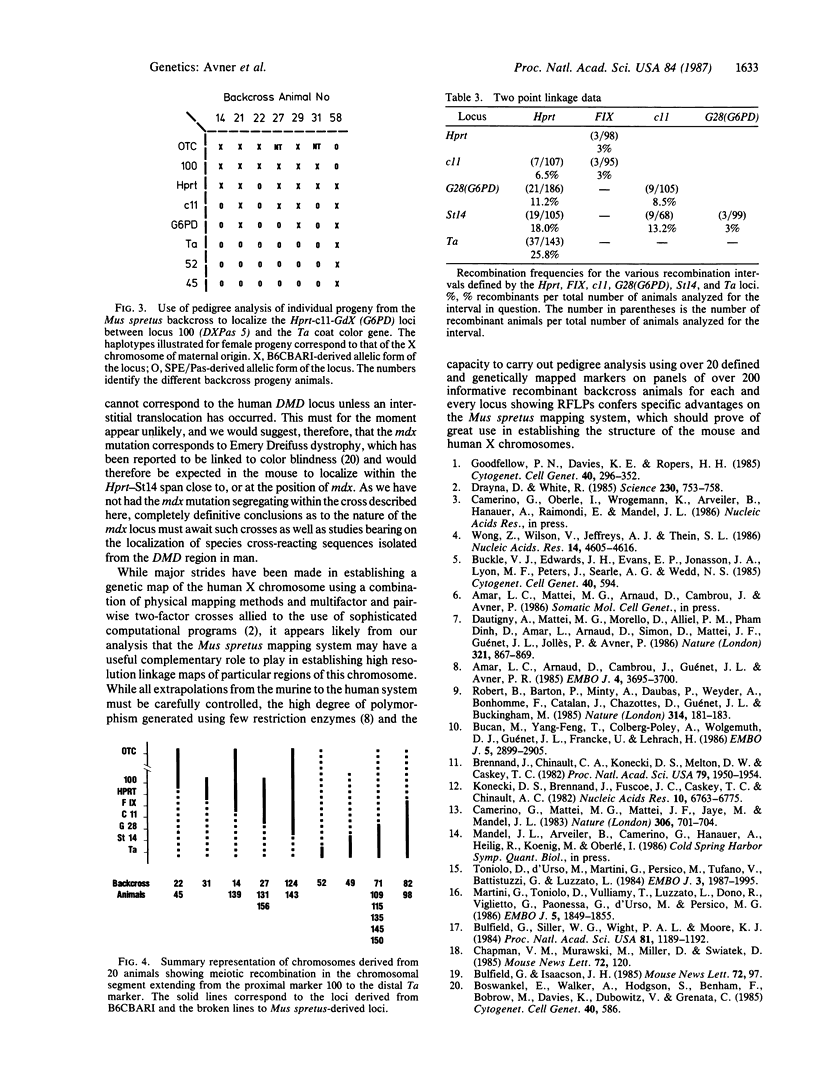
Images in this article
Selected References
These references are in PubMed. This may not be the complete list of references from this article.
- Amar L. C., Arnaud D., Cambrou J., Guenet J. L., Avner P. R. Mapping of the mouse X chromosome using random genomic probes and an interspecific mouse cross. EMBO J. 1985 Dec 30;4(13B):3695–3700. doi: 10.1002/j.1460-2075.1985.tb04137.x. [DOI] [PMC free article] [PubMed] [Google Scholar]
- Brennand J., Chinault A. C., Konecki D. S., Melton D. W., Caskey C. T. Cloned cDNA sequences of the hypoxanthine/guanine phosphoribosyltransferase gene from a mouse neuroblastoma cell line found to have amplified genomic sequences. Proc Natl Acad Sci U S A. 1982 Mar;79(6):1950–1954. doi: 10.1073/pnas.79.6.1950. [DOI] [PMC free article] [PubMed] [Google Scholar]
- Bulfield G., Siller W. G., Wight P. A., Moore K. J. X chromosome-linked muscular dystrophy (mdx) in the mouse. Proc Natl Acad Sci U S A. 1984 Feb;81(4):1189–1192. doi: 10.1073/pnas.81.4.1189. [DOI] [PMC free article] [PubMed] [Google Scholar]
- Bućan M., Yang-Feng T., Colberg-Poley A. M., Wolgemuth D. J., Guenet J. L., Francke U., Lehrach H. Genetic and cytogenetic localisation of the homeo box containing genes on mouse chromosome 6 and human chromosome 7. EMBO J. 1986 Nov;5(11):2899–2905. doi: 10.1002/j.1460-2075.1986.tb04585.x. [DOI] [PMC free article] [PubMed] [Google Scholar]
- Camerino G., Mattei M. G., Mattei J. F., Jaye M., Mandel J. L. Close linkage of fragile X-mental retardation syndrome to haemophilia B and transmission through a normal male. Nature. 1983 Dec 15;306(5944):701–704. doi: 10.1038/306701a0. [DOI] [PubMed] [Google Scholar]
- Dautigny A., Mattei M. G., Morello D., Alliel P. M., Pham-Dinh D., Amar L., Arnaud D., Simon D., Mattei J. F., Guenet J. L. The structural gene coding for myelin-associated proteolipid protein is mutated in jimpy mice. 1986 Jun 26-Jul 2Nature. 321(6073):867–869. doi: 10.1038/321867a0. [DOI] [PubMed] [Google Scholar]
- Drayna D., White R. The genetic linkage map of the human X chromosome. Science. 1985 Nov 15;230(4727):753–758. doi: 10.1126/science.4059909. [DOI] [PubMed] [Google Scholar]
- Goodfellow P. N., Davies K. E., Ropers H. H. Report of the Committee on the Genetic Constitution of the X and Y Chromosomes. Cytogenet Cell Genet. 1985;40(1-4):296–352. doi: 10.1159/000132178. [DOI] [PubMed] [Google Scholar]
- Konecki D. S., Brennand J., Fuscoe J. C., Caskey C. T., Chinault A. C. Hypoxanthine-guanine phosphoribosyltransferase genes of mouse and Chinese hamster: construction and sequence analysis of cDNA recombinants. Nucleic Acids Res. 1982 Nov 11;10(21):6763–6775. doi: 10.1093/nar/10.21.6763. [DOI] [PMC free article] [PubMed] [Google Scholar]
- Martini G., Toniolo D., Vulliamy T., Luzzatto L., Dono R., Viglietto G., Paonessa G., D'Urso M., Persico M. G. Structural analysis of the X-linked gene encoding human glucose 6-phosphate dehydrogenase. EMBO J. 1986 Aug;5(8):1849–1855. doi: 10.1002/j.1460-2075.1986.tb04436.x. [DOI] [PMC free article] [PubMed] [Google Scholar]
- Robert B., Barton P., Minty A., Daubas P., Weydert A., Bonhomme F., Catalan J., Chazottes D., Guénet J. L., Buckingham M. Investigation of genetic linkage between myosin and actin genes using an interspecific mouse back-cross. Nature. 1985 Mar 14;314(6007):181–183. doi: 10.1038/314181a0. [DOI] [PubMed] [Google Scholar]
- Toniolo D., D'Urso M., Martini G., Persico M., Tufano V., Battistuzzi G., Luzzatto L. Specific methylation pattern at the 3' end of the human housekeeping gene for glucose 6-phosphate dehydrogenase. EMBO J. 1984 Sep;3(9):1987–1995. doi: 10.1002/j.1460-2075.1984.tb02080.x. [DOI] [PMC free article] [PubMed] [Google Scholar]
- Wong Z., Wilson V., Jeffreys A. J., Thein S. L. Cloning a selected fragment from a human DNA 'fingerprint': isolation of an extremely polymorphic minisatellite. Nucleic Acids Res. 1986 Jun 11;14(11):4605–4616. doi: 10.1093/nar/14.11.4605. [DOI] [PMC free article] [PubMed] [Google Scholar]





